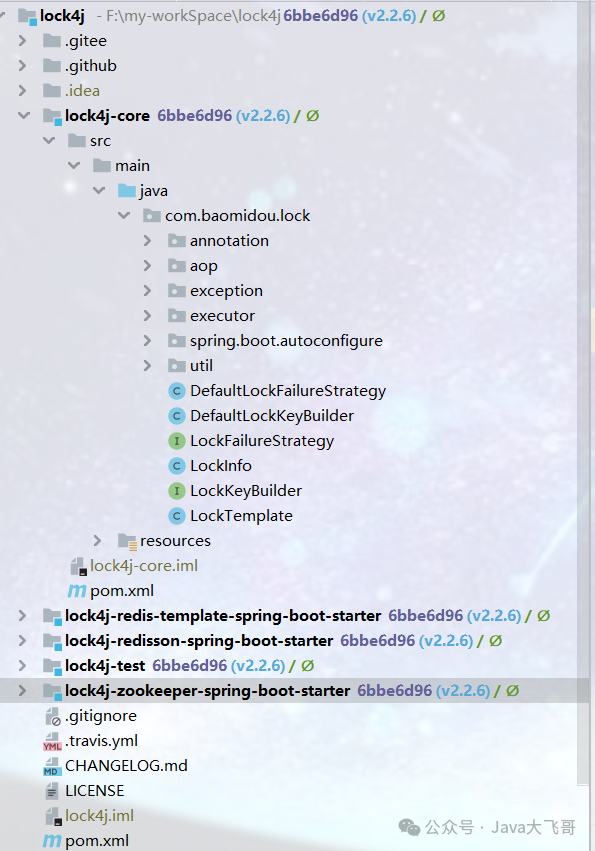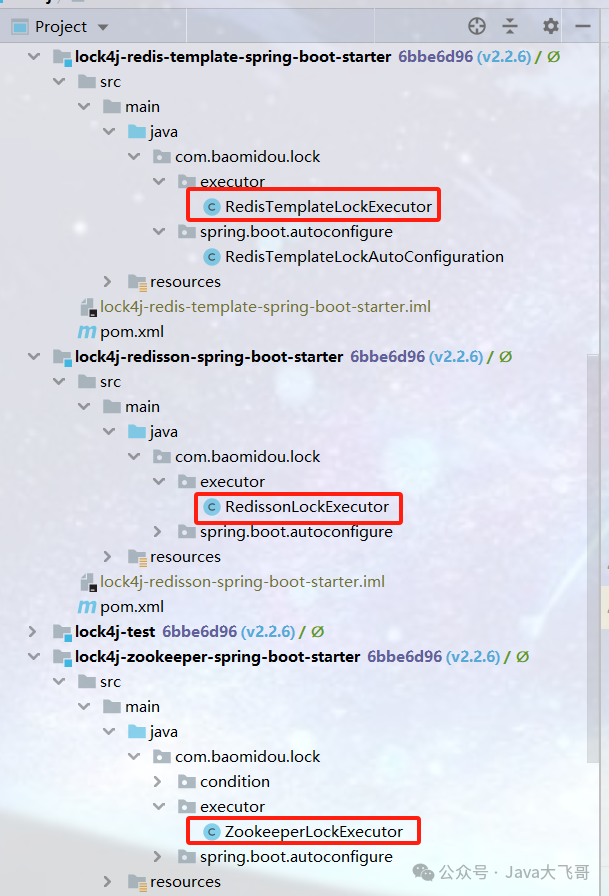文章目录
- 1.Lock4j是什么?
- 1.1简介
- 1.2项目地址
- 1.3 我之前手写的分布式锁和限流的实现
- 2.特性
- 3.如何使用
- 3.1引入相关依赖
- 3.2 配置redis或zookeeper
- 3.3 使用方式
- 3.3.1 注解式自动式
- 3.3.2 手动式
- 4.源码解析
- 4.1项目目录
- 4.2实现思路
- 5.总结
1.Lock4j是什么?
1.1简介
lock4j是苞米豆提供的一个分布式锁组件,其提供了多种不同的支持以满足不同性能和环境的需求。
立志打造一个简单但富有内涵的分布式锁组件。
1.2项目地址
https://gitee.com/baomidou/lock4j/tree/v2.2.6/
1.3 我之前手写的分布式锁和限流的实现
https://mp.weixin.qq.com/s/_MX4K_zXc2AbuvN-YrCzoA
https://blog.csdn.net/qq_34905631/article/details/139033796?spm=1001.2014.3001.5501
2.特性
- 简单易用,功能强大,扩展性强。
- 支持redission,redisTemplate,zookeeper。可混用,支持扩展。
3.如何使用
3.1引入相关依赖
<dependencies><!--若使用redisTemplate作为分布式锁底层,则需要引入--><dependency><groupId>com.baomidou</groupId><artifactId>lock4j-redis-template-spring-boot-starter</artifactId><version>${latest.version}</version></dependency><!--若使用redisson作为分布式锁底层,则需要引入--><dependency><groupId>com.baomidou</groupId><artifactId>lock4j-redisson-spring-boot-starter</artifactId><version>${latest.version}</version></dependency><!--若使用zookeeper作为分布式锁底层,则需要引入--><dependency><groupId>com.baomidou</groupId><artifactId>lock4j-zookeeper-spring-boot-starter</artifactId><version>${latest.version}</version></dependency>
</dependencies>
3.2 配置redis或zookeeper
spring:redis:host: 127.0.0.1...coordinate:zookeeper:zkServers: 127.0.0.1:2181,127.0.0.1:2182,127.0.0.1:2183
配置全局默认的获取锁超时时间和锁过期时间。
lock4j:acquire-timeout: 3000 #默认值3s,可不设置expire: 30000 #默认值30s,可不设置primary-executor: com.baomidou.lock.executor.RedisTemplateLockExecutor #默认redisson>redisTemplate>zookeeper,可不设置lock-key-prefix: lock4j #锁key前缀, 默认值lock4j,可不设置
acquire-timeout 可以理解为排队时长,超过这个时才就退出排队,抛出获取锁超时异常。
expire 锁过期时间 。 主要是防止死锁。 建议估计好你锁方法运行时常,正常没有复杂业务的增删改查最多几秒,留有一定冗余,10秒足够。 默认30秒是为了兼容绝大部分场景。
3.3 使用方式
3.3.1 注解式自动式
使用Lock4j注解
@Service
public class DemoService {//默认获取锁超时3秒,30秒锁过期@Lock4jpublic void simple() {//do something}//完全配置,支持spel@Lock4j(keys = {"#user.id", "#user.name"}, expire = 60000, acquireTimeout = 1000)public User customMethod(User user) {return user;}}
3.3.2 手动式
@Service
public class ProgrammaticService {@Autowiredprivate LockTemplate lockTemplate;public void programmaticLock(String userId) {// 各种查询操作 不上锁// ...// 获取锁final LockInfo lockInfo = lockTemplate.lock(userId, 30000L, 5000L, RedissonLockExecutor.class);if (null == lockInfo) {throw new RuntimeException("业务处理中,请稍后再试");}// 获取锁成功,处理业务try {System.out.println("执行简单方法1 , 当前线程:" + Thread.currentThread().getName() + " , counter:" + (counter++));} finally {//释放锁lockTemplate.releaseLock(lockInfo);}//结束}
}
关于其它高级功能可以参看项目地址的README.md有详细的说明
4.源码解析
4.1项目目录

4.2实现思路
利用了springBoot自动装配的能力解析配置文件和利用aop解析代用Lock4j注解的方法的类生成动态代理对象,根据不同的配置选择不同的分布式锁的实现,里面最关键的实现就是这个:
AbstractLockExecutor抽象类,提供了三种实现:

三种实现如下:

最关键的一个实现是LockTemplate类,源码如下:
/** Copyright (c) 2018-2022, baomidou (63976799@qq.com).** Licensed under the Apache License, Version 2.0 (the "License");* you may not use this file except in compliance with the License.* You may obtain a copy of the License at** http://www.apache.org/licenses/LICENSE-2.0** Unless required by applicable law or agreed to in writing, software* distributed under the License is distributed on an "AS IS" BASIS,* WITHOUT WARRANTIES OR CONDITIONS OF ANY KIND, either express or implied.* See the License for the specific language governing permissions and* limitations under the License.*/package com.baomidou.lock;import com.baomidou.lock.exception.LockException;
import com.baomidou.lock.executor.LockExecutor;
import com.baomidou.lock.spring.boot.autoconfigure.Lock4jProperties;
import com.baomidou.lock.util.LockUtil;
import lombok.Setter;
import lombok.extern.slf4j.Slf4j;
import org.springframework.beans.factory.InitializingBean;
import org.springframework.util.Assert;import java.util.LinkedHashMap;
import java.util.List;
import java.util.Map;
import java.util.concurrent.TimeUnit;/*** <p>* 锁模板方法* </p>** @author zengzhihong TaoYu*/
@SuppressWarnings("rawtypes")
@Slf4j
public class LockTemplate implements InitializingBean {private final Map<Class<? extends LockExecutor>, LockExecutor> executorMap = new LinkedHashMap<>();@Setterprivate Lock4jProperties properties;@Setterprivate List<LockExecutor> executors;private LockExecutor primaryExecutor;public LockTemplate() {}public LockInfo lock(String key) {return lock(key, 0, -1);}public LockInfo lock(String key, long expire, long acquireTimeout) {return lock(key, expire, acquireTimeout, null);}/*** 加锁方法** @param key 锁key 同一个key只能被一个客户端持有* @param expire 过期时间(ms) 防止死锁* @param acquireTimeout 尝试获取锁超时时间(ms)* @param executor 执行器* @return 加锁成功返回锁信息 失败返回null*/public LockInfo lock(String key, long expire, long acquireTimeout, Class<? extends LockExecutor> executor) {acquireTimeout = acquireTimeout < 0 ? properties.getAcquireTimeout() : acquireTimeout;long retryInterval = properties.getRetryInterval();LockExecutor lockExecutor = obtainExecutor(executor);log.debug(String.format("use lock class: %s", lockExecutor.getClass()));expire = !lockExecutor.renewal() && expire <= 0 ? properties.getExpire() : expire;int acquireCount = 0;String value = LockUtil.simpleUUID();long start = System.currentTimeMillis();try {do {acquireCount++;Object lockInstance = lockExecutor.acquire(key, value, expire, acquireTimeout);if (null != lockInstance) {return new LockInfo(key, value, expire, acquireTimeout, acquireCount, lockInstance,lockExecutor);}TimeUnit.MILLISECONDS.sleep(retryInterval);} while (System.currentTimeMillis() - start < acquireTimeout);} catch (InterruptedException e) {log.error("lock error", e);throw new LockException();}return null;}@SuppressWarnings("unchecked")public boolean releaseLock(LockInfo lockInfo) {if (null == lockInfo) {return false;}return lockInfo.getLockExecutor().releaseLock(lockInfo.getLockKey(), lockInfo.getLockValue(),lockInfo.getLockInstance());}protected LockExecutor obtainExecutor(Class<? extends LockExecutor> clazz) {if (null == clazz || clazz == LockExecutor.class) {return primaryExecutor;}final LockExecutor lockExecutor = executorMap.get(clazz);Assert.notNull(lockExecutor, String.format("can not get bean type of %s", clazz));return lockExecutor;}@Overridepublic void afterPropertiesSet() throws Exception {Assert.isTrue(properties.getAcquireTimeout() >= 0, "tryTimeout must least 0");Assert.isTrue(properties.getExpire() >= -1, "expireTime must lease -1");Assert.isTrue(properties.getRetryInterval() >= 0, "retryInterval must more than 0");Assert.hasText(properties.getLockKeyPrefix(), "lock key prefix must be not blank");Assert.notEmpty(executors, "executors must have at least one");for (LockExecutor executor : executors) {executorMap.put(executor.getClass(), executor);}final Class<? extends LockExecutor> primaryExecutor = properties.getPrimaryExecutor();if (null == primaryExecutor) {this.primaryExecutor = executors.get(0);} else {this.primaryExecutor = executorMap.get(primaryExecutor);Assert.notNull(this.primaryExecutor, "primaryExecutor must be not null");}}
}该LockTemplate模板类是通过lock4j-core的自动装配LockAutoConfiguration类在自动装配的时候解析了Lock4jProperties配置了,根据配置了去选择注入对应的锁实现,还有一个比较关键的类就是这个
LockInterceptor类:
/** Copyright (c) 2018-2022, baomidou (63976799@qq.com).** Licensed under the Apache License, Version 2.0 (the "License");* you may not use this file except in compliance with the License.* You may obtain a copy of the License at** http://www.apache.org/licenses/LICENSE-2.0** Unless required by applicable law or agreed to in writing, software* distributed under the License is distributed on an "AS IS" BASIS,* WITHOUT WARRANTIES OR CONDITIONS OF ANY KIND, either express or implied.* See the License for the specific language governing permissions and* limitations under the License.*/package com.baomidou.lock.aop;import com.baomidou.lock.LockFailureStrategy;
import com.baomidou.lock.LockInfo;
import com.baomidou.lock.LockKeyBuilder;
import com.baomidou.lock.LockTemplate;
import com.baomidou.lock.annotation.Lock4j;
import com.baomidou.lock.spring.boot.autoconfigure.Lock4jProperties;
import lombok.Builder;
import lombok.RequiredArgsConstructor;
import lombok.extern.slf4j.Slf4j;
import org.aopalliance.intercept.MethodInterceptor;
import org.aopalliance.intercept.MethodInvocation;
import org.springframework.aop.framework.AopProxyUtils;
import org.springframework.beans.factory.InitializingBean;
import org.springframework.core.OrderComparator;
import org.springframework.core.Ordered;
import org.springframework.core.annotation.AnnotatedElementUtils;
import org.springframework.util.StringUtils;import java.util.LinkedHashMap;
import java.util.List;
import java.util.Map;
import java.util.stream.Collectors;/*** 分布式锁aop处理器** @author zengzhihong TaoYu*/
@Slf4j
@RequiredArgsConstructor
public class LockInterceptor implements MethodInterceptor,InitializingBean {private final Map<Class<? extends LockKeyBuilder>, LockKeyBuilder> keyBuilderMap = new LinkedHashMap<>();private final Map<Class<? extends LockFailureStrategy>, LockFailureStrategy> failureStrategyMap = new LinkedHashMap<>();private final LockTemplate lockTemplate;private final List<LockKeyBuilder> keyBuilders;private final List<LockFailureStrategy> failureStrategies;private final Lock4jProperties lock4jProperties;private LockOperation primaryLockOperation;@Overridepublic Object invoke(MethodInvocation invocation) throws Throwable {//fix 使用其他aop组件时,aop切了两次.Class<?> cls = AopProxyUtils.ultimateTargetClass(invocation.getThis());if (!cls.equals(invocation.getThis().getClass())) {return invocation.proceed();}Lock4j lock4j = AnnotatedElementUtils.findMergedAnnotation(invocation.getMethod(),Lock4j.class);LockInfo lockInfo = null;try {LockOperation lockOperation = buildLockOperation(lock4j);String prefix = lock4jProperties.getLockKeyPrefix() + ":";prefix += StringUtils.hasText(lock4j.name()) ? lock4j.name() :invocation.getMethod().getDeclaringClass().getName() + invocation.getMethod().getName();String key = prefix + "#" + lockOperation.lockKeyBuilder.buildKey(invocation, lock4j.keys());lockInfo = lockTemplate.lock(key, lock4j.expire(), lock4j.acquireTimeout(), lock4j.executor());if (null != lockInfo) {return invocation.proceed();}// lock failurelockOperation.lockFailureStrategy.onLockFailure(key, invocation.getMethod(), invocation.getArguments());return null;} finally {if (null != lockInfo && lock4j.autoRelease()) {final boolean releaseLock = lockTemplate.releaseLock(lockInfo);if (!releaseLock) {log.error("releaseLock fail,lockKey={},lockValue={}", lockInfo.getLockKey(),lockInfo.getLockValue());}}}}@Overridepublic void afterPropertiesSet(){keyBuilderMap.putAll(keyBuilders.stream().collect(Collectors.toMap(LockKeyBuilder::getClass, x -> x)));failureStrategyMap.putAll(failureStrategies.stream().collect(Collectors.toMap(LockFailureStrategy::getClass, x -> x)));LockKeyBuilder lockKeyBuilder;LockFailureStrategy lockFailureStrategy;List<LockKeyBuilder> priorityOrderedLockBuilders = keyBuilders.stream().filter(Ordered.class::isInstance).collect(Collectors.toList());if (lock4jProperties.getPrimaryKeyBuilder() != null) {lockKeyBuilder = keyBuilderMap.get(lock4jProperties.getPrimaryKeyBuilder());} else if (!priorityOrderedLockBuilders.isEmpty()) {sortOperation(priorityOrderedLockBuilders);lockKeyBuilder = priorityOrderedLockBuilders.get(0);} else {lockKeyBuilder = keyBuilders.get(0);}List<LockFailureStrategy> priorityOrderedFailures = failureStrategies.stream().filter(Ordered.class::isInstance).collect(Collectors.toList());if (lock4jProperties.getPrimaryFailureStrategy() != null) {lockFailureStrategy = failureStrategyMap.get(lock4jProperties.getPrimaryFailureStrategy());} else if (!priorityOrderedFailures.isEmpty()) {sortOperation(priorityOrderedFailures);lockFailureStrategy = priorityOrderedFailures.get(0);} else {lockFailureStrategy = failureStrategies.get(0);}primaryLockOperation = LockOperation.builder().lockKeyBuilder(lockKeyBuilder).lockFailureStrategy(lockFailureStrategy).build();}@Builderprivate static class LockOperation{/*** key生成器*/private LockKeyBuilder lockKeyBuilder;/*** 锁失败策略*/private LockFailureStrategy lockFailureStrategy;}private LockOperation buildLockOperation(Lock4j lock4j){LockKeyBuilder lockKeyBuilder;LockFailureStrategy lockFailureStrategy;Class<? extends LockFailureStrategy> failStrategy = lock4j.failStrategy();Class<? extends LockKeyBuilder> keyBuilderStrategy = lock4j.keyBuilderStrategy();if (keyBuilderStrategy == null || keyBuilderStrategy == LockKeyBuilder.class) {lockKeyBuilder = primaryLockOperation.lockKeyBuilder;} else {lockKeyBuilder = keyBuilderMap.get(keyBuilderStrategy);}if (failStrategy == null || failStrategy == LockFailureStrategy.class) {lockFailureStrategy = primaryLockOperation.lockFailureStrategy;} else {lockFailureStrategy = failureStrategyMap.get(failStrategy);}return LockOperation.builder().lockKeyBuilder(lockKeyBuilder).lockFailureStrategy(lockFailureStrategy).build();}private void sortOperation(List<?> operations){if (operations.size()<=1){return;}operations.sort(OrderComparator.INSTANCE);}}
aop解析到加了@Lock4j注解方法的类上根据注解的属性(过期时间,keys通过SPEL表达式解析到的,超时时间,失败策略,keys生成策略,锁是否自动释放,方法名称,失败策略等)生成动态代理,在目标对象的目标方法被调用前会被LockInterceptor拦截器invoke方法会执行,在执行目标方法前对其进行功能增强,LockInterceptor的invoke方法会调用lockTemplate.lock方法进行加锁,而lockTemplate.lock方法是对三种分布式锁实现的一个模板统一的抽象,具体实现会下沉到不同的实现starter里面,给个实现的starter也会通过spirngBoot的自动装配,LockAutoConfiguration会把所有的锁实现的LockExecutor
@Bean@ConditionalOnMissingBeanpublic LockTemplate lockTemplate(List<LockExecutor> executors) {LockTemplate lockTemplate = new LockTemplate();lockTemplate.setProperties(properties);lockTemplate.setExecutors(executors);return lockTemplate;}
装配到LockTemplate的executors属性上
@Setterprivate List<LockExecutor> executors;
在LockTemplate的afterPropertiesSet的方法会在spring属性注入后置操作的一个接口,会根据Lock4jProperties配置的执行器设置主执行器,会把所有分布式锁的执行器的bean放到了executorMap中
@Overridepublic void afterPropertiesSet() throws Exception {Assert.isTrue(properties.getAcquireTimeout() >= 0, "tryTimeout must least 0");Assert.isTrue(properties.getExpire() >= -1, "expireTime must lease -1");Assert.isTrue(properties.getRetryInterval() >= 0, "retryInterval must more than 0");Assert.hasText(properties.getLockKeyPrefix(), "lock key prefix must be not blank");Assert.notEmpty(executors, "executors must have at least one");for (LockExecutor executor : executors) {executorMap.put(executor.getClass(), executor);}final Class<? extends LockExecutor> primaryExecutor = properties.getPrimaryExecutor();if (null == primaryExecutor) {this.primaryExecutor = executors.get(0);} else {this.primaryExecutor = executorMap.get(primaryExecutor);Assert.notNull(this.primaryExecutor, "primaryExecutor must be not null");}}
然后在LockTemplate的lock方法中去找到一个执行器实现,然后去加锁解锁等操作
LockExecutor lockExecutor = obtainExecutor(executor);
大致上的一个实现源码思路解析就是上面哪些,RedisTemplateLockExecutor的实现其实是利用redisTemplate先redis提交执行了一下两个luna脚本:
private static final RedisScript<String> SCRIPT_LOCK = new DefaultRedisScript<>("return redis.call('set',KEYS[1]," +"ARGV[1],'NX','PX',ARGV[2])", String.class);private static final RedisScript<String> SCRIPT_UNLOCK = new DefaultRedisScript<>("if redis.call('get',KEYS[1]) " +"== ARGV[1] then return tostring(redis.call('del', KEYS[1])==1) else return 'false' end", String.class);private static final RedisScript<Boolean> SCRIPT_RENEWAL = new DefaultRedisScript<>("if redis.call('get', KEYS[1]) ==ARGV[1] " +"then return redis.call('pexpire', KEYS[1], ARGV[2]) else return 0 end", Boolean.class);
他的这个实现就是redisson实现的简化版本,redisson的实现原理其实也是利用luna脚本语言执行的原子特性,redisson作为一个开源的分布式锁实现框架,还提供了其它的一些能力不至于分布式锁,它提供的锁的类型姿势功能更多更丰富和强大,ZooKeeper分布式锁的实现主要依赖于其的特性。
5.总结
Lokck4j实现分布式锁的使用、原理和源码就都已经分享完了,zk看他的配置是支持多节点高可用的,但是对于redis实现的分布式锁,看着只可以配置一个单节点,所以redis方式就存在单节点风险,跟我之前那个实现有同样的问题,redis节点下可以正常使用,多节点发生主备切换,主节点宕机从节点顶上的一瞬间就可能会重复加锁,之前节点加的锁没有释放等问题,所以就需要重新拓展实现一下才行,Lokck4j提供的这个限流的功能有限,可以使用我上面写那个好用开源的轮子,可以解决业务上遇到的限流问题,你可以使用我写的开源的轮子或者是使用这个Lock4J让你写的业务代码中使用分布式锁的姿势更加优雅或者你可以写其它的实现方式,Lock4J的源码写的确实优雅,用到了建造者模式、模板方法模式、桥接模式、策略模式等设计模式,使用好的设计模式和设计思想,可以使写出的代码高内聚,低耦合,鲁棒性更强,可拓展性更强、可维护性更高,养成良好的编码习惯尤为重要,写出干净整洁优美优雅的代码,让代码可读性更强,我的分享到此结束,希望对你有所启发和帮助,请一键三连,么么么哒!




加载 action)






)







